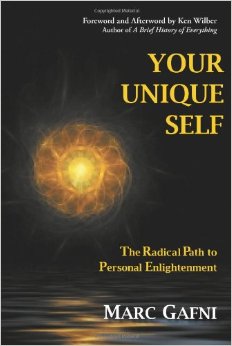TRANSLATE THIS ARTICLE
Integral World: Exploring Theories of Everything
An independent forum for a critical discussion of the integral philosophy of Ken Wilber
SEE MORE ESSAYS WRITTEN BY FRANK VISSER
Does Love Really Make the World Go Round?
Marc Gafni's paraphrasing or plagiarizing
of Ken Wilber's pseudo-cosmology
Frank Visser
But you can't make molecules with metaphors. Poetry doesn't create protons. At least not in this world.
In Marc Gafni's highly praised and popular book Your Unique Self (Integral Publishers, 2012), we read in Appendix I called "Evolutionary Love" (p. 405-407) the following story about what makes the universe tick:
Let's start with the big bang. Here, separate subatomic units, which
physicists have called quarks, are the only forms in existence. Some force
then moves these separate quarks to transcend their merely separate existence
and reach for a level of union with other quarks. They are attracted
to each other, allured by each other. This implicit allurement is the face of
mystery itself. It did not have to be this way. The mutually attracted and
allured atoms recognize each other and embrace. Separate subatomic units
are moved to form a single unit. A boundary drops around them. Whole
atoms are formed. What moves them? The Eros of evolution, which is the
Eros of love.
Then it happens again. Various groups of separate atoms are moved by a
mysterious force to come together. Separate atoms recognize each other in
union and embrace. This is Eros as allurement. Molecules are formed. What
drives this process? There is a self property inherent in matter itself that
moves toward higher and higher levels of mutuality, recognition, union, and
embrace. It is this mysterious internal Eros that drives separate subatomic
particles to form a new union, an atom, and which drives the separate atoms
to form a new union, a molecule.
Then it happens again. Separate molecules, what are called complex molecules,
are in proximity to each other. Against all statistical probability, these
separate complex molecules come together, reaching for higher and deeper
levels of mutuality, recognition, union, and embrace. A separate boundary
falls around them. The first cell is formed. Life is born. (....)
Then it happens again. Numerous perfectly tailored cells are all brought
together into a single functioning unit with one boundary. Multicellular
organisms are formed. The Eros of evolution dances up the evolutionary
spiral to higher and higher levels of complexity, and deeper consciousness
emerges from the evolutionary soup. It is a continual process of selforganization
through self-transcendence, in which self transcends itself to
recognize and join other in higher embrace. Love by any other name. The
evolutionary ladder continues to spiral to ever-higher and deeper levels of
complexity and consciousness. Each higher level is always defined by everhigher
levels of mutuality, recognition, union, and embrace between the
evolving cells and organisms. Plants, amphibians, mammals, then higher
mammals, until we get to the full bloom of human consciousness. This is
the Great Story of One Love. Evolutionary Love.
Compare this to Ken Wilber's introductory talk at the third Integral Spiritual Experience Seminar ("Kosmic Creativity", held December 28th, 2011 - January 1st, 2012):
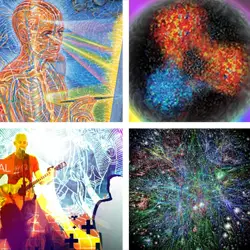
Whether we see this in a spiritual way or in a more material way, the fact is there is creative emergence. There is evolution. Going all the way back to the earliest particles or strings or whatever physics is suggesting... at some point, these quarks, following their own strict causality, at some point, nonetheless, a boundary dropped around these particles and this produced protons. And another group of quarks came together and another boundary dropped around those and this produced neutrons. And another group of quarks came together and a boundary dropped around them and this produced electrons. And for a very long time, these individual particles went their own independent way.
The degree of novelty was relatively small, and they were indeed determined by the past they were prehending. They were determined by their previous moment's existence, they had to include in order to continue to exist.... [here comes a passage about Hegel, which I will spare you]...
So we saw these earliest quarks transcending-and-including, transcending-and-including, and at one point, the transcend-component became enormously greater then the include-component, and groups of quarks came together and transcended to create new particles. And it did this in a great number of cases.
So the universe, in addition to containing quarks or strings or whatever fundamental item we are talking about, in addition to possessing quarks it now possessed protons and neutrons and electrons. And these went on about their moment-to-moment existence, transcending-and-including the previous moment, and at some point the novelty-component, the emergent-component, the evolutionary Eros — the transcendental drive — overcame the merely prehensive or merely including component, and protons and neutrons and electrons came together to form atoms.
And so we started to get Hydrogen, and Helium and Oxygen and Nitrogen, and Potassium and Sodium and so on, starting to populate the universe. And this in itself is really extraordinary, given that none of this really existed with the Big Bang.
And yet the drive, that fundamental drive to creativity — it has been given many names, including self-organisation and Eros — but this Eros has this extraordinary capacity to fundamentally govern this "creative advance into novelty". And what we continue to say after this creation of atoms is this continuing march into novelty...
Or compare this paragraph from Ken Wilber, taken from EnlightenNext, nr. 47, 2011,"The Cosmic Dimensions of Love" (no longer online):
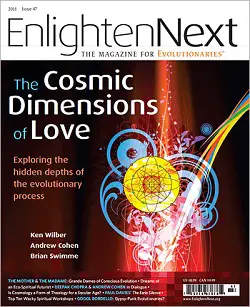
"I mean, think about it. At one point in history, there was nothing but atoms wandering around. And one day, several atoms got together and were just kind of sitting there, having a little tea party, when all of a sudden, a single membrane drops around them and they form a single molecule. All of these atoms become one molecule.
Now, it's really astonishing that universe would do this. Some think that this is some sort of chance, random mutation?but that, in fact, is exactly what it isn't. It's the opposite of chance or randomness.
It's evidence of a force that is pushing against randomness in the universe.
Now, if the emergence of molecules wasn't astonishing enough, the real kicker is that dozens of these molecules, each of a different type, each playing a different role, got together for the next party. They were just hanging out, kind of boogying and dancing around. Then all of a sudden a membrane drops around them and a single cell emerges. And what's more, it's alive. It can reproduce.
The fact that such a thing can happen is a miracle. It's just unbelievable.
Cells wandered around for a long time. Eventually, some of them got together. And pow! Another single boundary drops around them, and multicellular organisms and plant life emerge. And on and on it goes, with higher unities being created as you move from plant life into locomotive life and the emergence of animals, and then animals get more and more complex as a neural net drops down and emerges, and then a reptilian brain stem, and then a limbic system, and then a paleomammalian brain, and then a cortex. And then something new with human beings: a neocortex that makes it possible for you to comprehend these words.
All of this, without exception, is driven by love.
The great philosophers throughout history have referred to it by many names. Eros is one of the most common.
Now, Neo-Darwinian evolutionary theory holds that all these transformations upward were just the result of chance and randomness. But there is no way in hell that the universe went from atoms to Shakespeare out of random stabs. This is an extraordinarily driven process."
Now I couldn't care less who was first with developing these trains of thought—Wilber or Gafni—what I care most about is how useful or true or meaningful such a presentation is. Still, one wonders if Gafni has co-opted Wilber's phraseology for his own book, adding some characteristics of his own: the cosmos as Love Story. This is visible in phrases like "a boundary drops around them", "what drives this process?", "a mysterious force", "self-organization and self-transcendence" and "against all statistical probability". Of course, this is standard integral phraseology, and Wilber and Gafni worked closely together on preparing several Integral Spiritual Experience seminars, but it is still striking that these ideas are not credited, as far as I can see, in Your Unique Self[1].
The general point I would like to make: is it possible to make cross-domain generalizations that are more than just inspiring poetry?
But you can't make molecules with metaphors. Poetry doesn't create protons. Not in this world. The general point I would like to make: is it possible to make cross-domain generalizations—that hold true across the domains of matter, life, mind and culture—that are more than just inspiring poetry or empty abstractions (such as "emergence")? Does love really make the world go round? And is Wilber (or Gafni) communicating a system of meaning, to make sense of the world in a spiritual sense, or is he making statements that make a difference in the world of science? This is where it gets muddy, for whenever Wilber (or Gafni) refer to the findings of science, their aim is not so much to educate scientists, but to convince his readers that his particular brand of "evolutionary spirituality" is keeping pace with the most recent findings of science.
Superficially seen, things "get together" on a cosmic scale, building galaxies, as well as on smaller scales, where molecules, cells and multi-cellular organisms are formed. The bigger question is of course: how does that work? Are these all entities that might just as well not have been there? Is there no necessity for these entities to arise in the cosmos? So that we should resort to some mysterious force that created them? A "drive towards self-organization"? A "mysterious internal Eros"? A "drive towards creativity"? A "fifth force" even? As Gafni states:
Leading-edge scientific thinkers are now searching to identify the animating
quality of the evolutionary impulse. Some thinkers describe the complex
self-organizing system of the Uni-verse as the great web of life. The leading
edge of systems theory, and chaos or complexity theory, deal specifically with
the mysterious workings of this force, which is sometimes called the fifth
force of the Uni-verse. The fifth force is the energy of attraction (which I
would call Eros) that brings things together, called the “fifth” to distinguish it
from the four physical forces that govern reality. The first four forces are generally
thought to be nuclear, gravitational, magnetic, the strong, and the weak.
The fifth force is the inherent tendency of matter to self-organize, to rise
above a chaotic state to more complex forms that are more unified. Seen from
the inside by the great realizers, through the eye of the spirit, each level of
complexity is innately more conscious, which ultimately means more loving. (Your Unique Self, p. 414)
Internal drives or the proper conditions?
I have often argued that this theory of drives is not really helpful in explaining these various phenomena. The standard example I give is that of a hurricane. A hurricane doesn't arise out of nowhere because of some "internal drive towards hurricanes", but whenever certain natural conditions have been met. Without these conditions, hurricanes will never happen. With them, they will invariably do. And within each of the large domains these conditions might be different.
When we look at how science covers these domains, at least of matter and life, the atmosphere changes considerably. Conclusions reached there are far less sweeping then the flights of mystical poetry, but the illumination is there no less. Take the problem of simple Hydrogen atoms, present soon after the start of the Big Bang, transforming into heavier elements, such as Carbon, Magnesium, Nitrogen, all the way up to the very unstable elements at the end of the Periodic System. It would be tempting to say there's an "internal drive towards complexity" in matter, that results in all of the heavier elements, heavier than Hydrogen, that is.
Case closed! Or not?
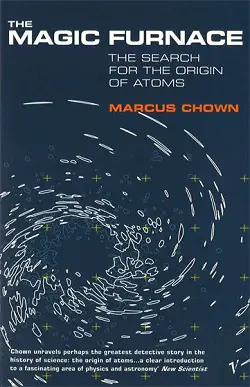
The science story about the genesis of the elements reads as a detective story spanning multiple decades, many setbacks and ultimate triumphs. In The Magic Furnace (new edition, 2000) Marcus Choun provides a fascinating read of what happened in this area, since the scientific search for this question was on. At first, it was unclear how many of the heavier elements could have formed at all. The pressure and temperature in the inside of common stars just wasn't high enough to compress protons so larger nuclei could be forged. Until super-nova's where postulated and discovered, which provided exactly the right furnaces for these processes of nucleosynthesis. And don't think these giants where the home of "cosmic love": the inside of supernovae are the most hellish environments you can imagine. Even then, some elements, such as Lithium, Berylium and Borium, which come right after Hydrogen and Helium, appeared to have been formed by a process called "cosmic ray spallation". For other out-of-the-ordinary elements, "quantum tunneling" was discovered. It's a fascinating field, far outside of the expertise of integral mystics. Gravity is driving this, beginning to end, so no need for another attractive force.
Take another field: how do molecules evolve? Only just recently, a Dutch team of chemists headed by chemistry professor Sijbren Otto has unraveled how this could be done. In an article in Nature Chemistry (January 6th, 2016) called "Diversification of self-replicating molecules" (for a summary, see: "The origins of abiotic species" on phys.org) an effort was made "to see if self-organization and autocatalysis will provide the answer." But pay attention: we are now not bringing in a "internal drive towards molecules" in Nature, but real scientific explanations of this mysterious process. He discovered that some proteins spontaneously formed into rings, which in turn could form stacks. And these stacks would break, to form new "species" of protein stacks. This replication process happened only when the proteins were provided with building blocks ("food"). Thus chemical evolution is clarified—admittedly a far cry from biological species evolution, but a good start to understand this at the molecular level.
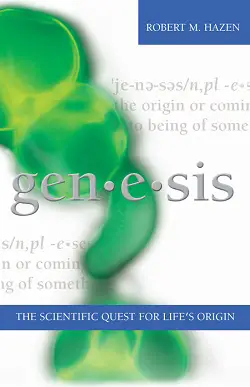
Another field of science. The origin of life is still an unresolved mystery. That doesn't mean science hasn't booked progress. We discussed in an earlier essay, "The Two Greatest Experiments of Life", the work of Robert M. Hazen, who argued that complex life could arise "against all odds". This touches on the question of entropy, so misunderstood by Wilber (and friends), in the sense that his system needs a spiritual Force responsible for complexity which works against the forces of chance and increasing entropy (or disorder) in the universe. Science, in contrast, doesn't see a problem here. Says Hazen: "Systems as a whole do tend to become more disordered with time, but at the local scale of a cell, an ant colony, or your conscious brain, remarkable complexity emerges. " (Genesis, p. 12). He even discusses the notion of an unkown force ("The Missing Law" is a paragraph heading) that could account for this rise in complexity, but other than Wilber (and Gafni), who eagerly embrace such a notion because it seems to bolster their spiritual worldview, Hazen soberly concludes that complex systems can emerge when energy flows through them. The Second Law of Thermodynamics ("disorder increases") is not violated on a global scale, even if on local scales, such as the Earth, complexity and order increase. Needless to say, notions of "a fifth force" that creates complexity (how exactly is typically never explained) are not helpful here.
We could go on and on. The well-known (though once fiercely opposed) theory of endosymbiosis or symbiogenesis developed by Lynn Margulis states that cellular organelles like chloroplasts and mitochondria once were free living bacteria. They still contain their own DNA, have their own way of dividing and essentially make plants and animals possible in the first place. It is amazing if you think of it that where Darwin (and Dawkins) cover the origin of species, this is another ballgame. Lynn Margulis clarified the origin of whole kingdoms, such as plants, animals and fungi, which were the result of a sequence(!) of endosymbiotic events in which bacteria were included in prokaryotic organisms, to enable them to feed on light and water, or to burn sugars. Again, an airy fairy story about transcend-and-include can be imagined where these bacteria got "included" in the larger organisms, thereby "transcending" their separate and independent existence. But the story is slightly different, especially when told by the rebellious Margulis. She tells a tale of cannibalism and half-digested bacteria that ended up surviving within other organisms, to the benefit of both. As she liked to say: "Gaia is a tough bitch!"—definitely not a Loving Goddess.
Is it still meaningful to summarize these naturalistic processes, with the help of the "eye of spirit", as being driven by Love? I doubt it. Especially when this relatively innocent poetic notion is turned into an alternative form of "evolutionary spirituality", in which the "evolutionary impulse" behind the cosmos can be contacted and aligned to, as both Wilber and Gafni are eager to promote. Is gravity really some kind of "intelligent attraction" as integral creationism would have it? Science, in and by itself, is illuminating enough, if we really want to understand the universe and our place in it.
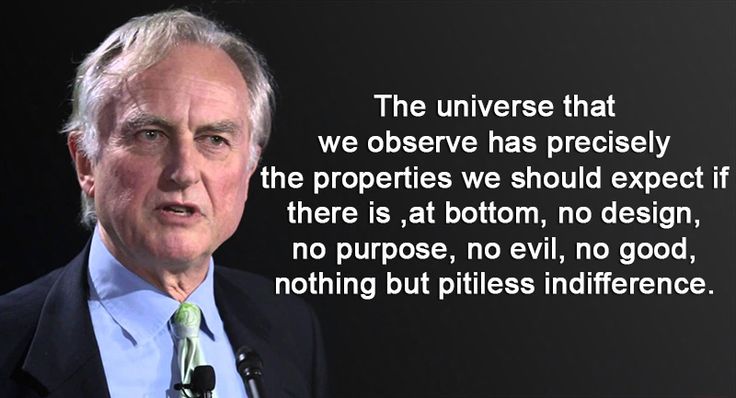
Or, if you think that is a bit hard to stomach:
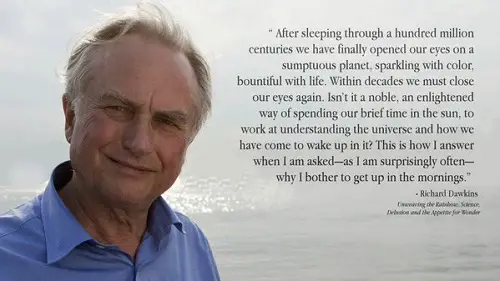
NOTES
[1] A footnote in the cited chapter from Your Unique Self" reads: "This essay emerged from the first dialogue in the Future of Love Series between Ken Wilber and
Marc Gafni. It is a version of that core content which additional pieces integrated at a later date
by Marc. This might be considered a first take on this material. A fuller essay on Evolutionary
Love by Ken and Marc is forthcoming in a future publication." It is unclear from this note what ideas or phrases can be attributed to whom.
|

 Frank Visser, graduated as a psychologist of culture and religion, founded IntegralWorld in 1997. He worked as production manager for various publishing houses and as service manager for various internet companies and lives in Amsterdam. Books: Ken Wilber: Thought as Passion (SUNY, 2003), and The Corona Conspiracy: Combatting Disinformation about the Coronavirus (Kindle, 2020).
Frank Visser, graduated as a psychologist of culture and religion, founded IntegralWorld in 1997. He worked as production manager for various publishing houses and as service manager for various internet companies and lives in Amsterdam. Books: Ken Wilber: Thought as Passion (SUNY, 2003), and The Corona Conspiracy: Combatting Disinformation about the Coronavirus (Kindle, 2020). 